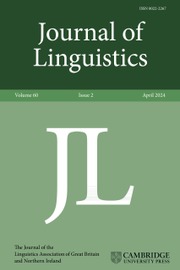No CrossRef data available.
Article contents
See-in: A case of lexically-governed, non-clausal predication1
Published online by Cambridge University Press: 11 November 2014
Abstract
The see-in construction, exemplified in sentences like John sees/finds in Mary his best friend involves a relation of predication between the DPs Mary and his best friend. It provides evidence against the hypothesis that predication relations are established uniformly within the syntactic context of clausal structure. The empirical facts show that [in Mary] and [his best friend] in this example are both complements of see/find. It follows that Mary and his best friend could not possibly be syntactically related as the subject and predicate of a clause, despite the fact that they are engaged in a semantic relation of predication.
Information
- Type
- Notes and Discussion
- Information
- Copyright
- Copyright © Cambridge University Press 2014
Footnotes
I am thankful to three anonymous Journal of Linguistics referees as well as to the editor Caroline Heycock for many helpful comments and suggestions.


